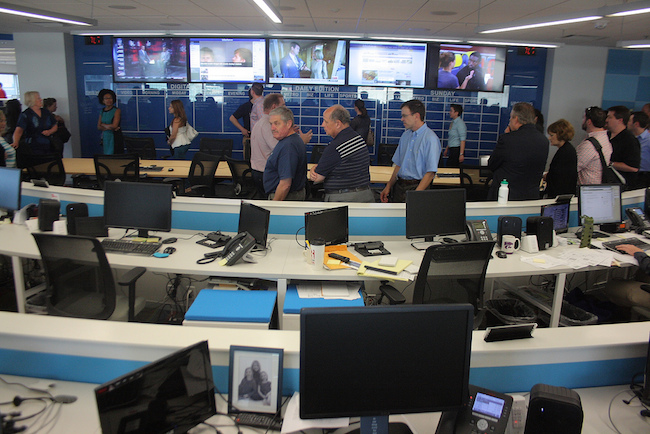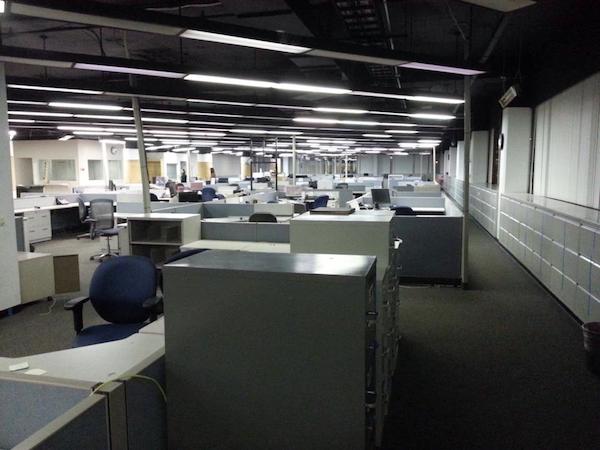
The Des Moines Register said goodbye to almost a century worth of memories in June when it left its 13-story home for a floor-and-a-half of commercial real estate in what had been vacant office space.
The newspaper had a lot of goodbyes, many of them painted poignantly by Iowa columnist Kyle Munson in a series boldly called “Tradition on the Move.” And there’s a lot to say hello to as well, including the chance to use physical space as a way to sell people on the Register’s digital vision.
If there was ever a prime example of a newsroom built for a world of mechanical, industrial news production, the Register (née Register and Tribune) building was it: 13 stories organized top down, from publisher to printing press — a newspaper building constructed to accommodate the machinery and people required to get out a paper to all 99 Iowa counties.
A metro journalist recalled: “This was this massive industrial building with pneumatic tubes screeching overhead…I miss the industrial feel of the old building, but there aren’t really industries in America anymore.”
That industrial feel has been symbolically quashed, as the newsroom now works just a few blocks away on one floor of a shiny, well-lit, screen-filled commercial office space in a building called Capitol Square. (For a full gallery of photos of the new space, look here.)

The old newsroom. Photo by R.D. Shacklett.
It seems that, on net, saying goodbye to the old space has been seen as a strategic win for the newspaper. The Register is aiming to use its new space as a way to convince people that it has vitality and a future. The argument is intended to reach everyone: prospective employees, advertisers, and community members.
On the surface, what Des Moines has done sounds a lot like what other newspapers have tried to do with moves into new spaces. But the way that people talk about the result is different — here, people beyond just those involved with its creation, and with almost no prompting, talk about the importance of new space to an argument about the future.
The new building boasts a “Mission Control” semi-circle for breaking news and key assignment editors. On the way into the newsroom, a series of screens offer the latest newspaper wins, digital video stats, ad stats, awards, or simply a shoutout to the newest employee.
The newsroom has more screens featuring realtime analytics, and a series of blue boards designed as write-on boards for digital, Sunday, and weekend planning — all subjects once relegated to the screens of a few people or to the back of a faraway meeting room.
The names of conference rooms and open spaces were all voted on by committees, including my personal favorite, the Baconfest room, featuring a picture of bacon and a bacon centerpiece on the table.
Young journalists have been particularly excited to come work in the space. I spoke to three young journalists who had just been hired who said that they had been wowed by the Des Moines newsroom, which was simply unlike the other newsrooms they had ever seen.
One journalist, Jeniece Smith, put it this way: “We have print, digital screens, stats for the site, we can see our competitors — we are really plugged in. They spared no expense to get what we want done. There is certainly no newsroom like this in Iowa and I want to say in the Midwest.” She told me she felt “lucky” to be in Des Moines.
A long-time editor, Randy Brubaker, beamed when he talked about showing off the space. He said he wished he could have all of the subscribers come up and visit because he believed that newsroom was a visible way to show all the good effort the newspaper was making into digital inroads.
Brubaker recently had a college class of public relations students visit and was pleased by their responses to the newsroom. “One of them said, ‘Wow, I never expected a newspaper to look like this,'” he said. “If we are impressing college kids with the workspace, with the environment, with clean, open technology, then that is at least 50 percent of the battle to keep kids interested and show them that the newspaper is still vital and has vitality.”
To the big-city people who might be reading this and thinking that I’m puffing up an office move with sweet feedback, hold your skepticism for a moment. The comparisons young journalists are making are to 10,000-, 20,000-, or 50,000 circulation newspapers, if that. Des Moines is, well, Des Moines, and so young PR students visiting a number of media properties in the area have a sense of relative comparison.
But being the big dog matters to the bottom line. For the Register, the new space means it can bring advertisers into the newsroom and impress them with this showpiece. It’s advertising for the newspaper, so the newspaper can in turn get more advertising.
Publisher Rick Green explained that the newsroom was working as a showpiece. “It shows how we are evolving, after 95 years of being a legacy print organization, to be a digital powerhouse.” The newsroom recently had an open house for advertisers and Gannett bigwigs, and Green said those visitors “could see that we were physically and mentally situated to do our job in a new way.”
Even as Des Moines thinks about alternative revenue streams, impressing advertisers is duly important. One strategy the newspaper is taking is to become more of an advertising strategy company itself. For instance, Green hopes that the new video studio built for the newsroom will one day be also well used by the ad side; other staffers recalled with some amusement how the very wealthy corporate executives had paid a visit to the newsroom and played with the new green screen.
The argument goes something like this: If advertisers believe that The Des Moines Register knows what it is doing with its journalism, and that it is looking and acting future-forward, then advertisers will be more interested in connecting the Register with their brand. Perhaps the architecture is indeed all smoke and mirrors — but for now, it may at least be one hope for the near turn for resurrecting the dinosaur image of news.
Photo of a tour of the new Register newsroom by Gregory Hauenstein used under a Creative Commons license.